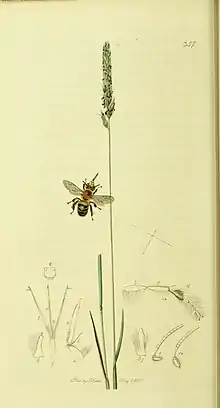| Anthophora retusa | |
|---|---|
 | |
| Scientific classification | |
| Domain: | Eukaryota |
| Kingdom: | Animalia |
| Phylum: | Arthropoda |
| Class: | Insecta |
| Order: | Hymenoptera |
| Family: | Apidae |
| Genus: | Anthophora |
| Species: | A. retusa |
| Binomial name | |
| Anthophora retusa | |
| Synonyms | |
|
Anthophora monacha[2] | |
Anthophora retusa, the potter flower bee, is a species of solitary digger bee.[5]
Distribution
A. retusa is generally found in Western Europe and southern Sweden.[6] In the United Kingdom, A. retusa is thought to be limited to five sites, including Seaford Head Nature Reserve.[7]
Identification
A. retusa can be differentiated from Anthophora plumipes by the hind-tibial spurs; in A. plumipes they are black while in A. retusa they are yellow or yellow-brown.[2]
Habitat
A. retusa prefers sandy soils and is generally found on coastal dunes and cliffs as well as inland on commons and heathlands.[2][5]
Population
A. retusa has suffered population decline since the Second World War but undergone rapid decline since the 1990s,[7] similar to that seen in some bumblebee species.[5][8] It is an endangered species in Britain.[9][10]
References
- ↑ "Anthophora retusa (Linnaeus, 1758)". NBN Atlas Scotland. Retrieved 22 September 2020.
- 1 2 3 "Anthophora retusa (Linnaeus,1758)". BWARS. Retrieved 22 September 2020.
- 1 2 "Anthophora (Pyganthophora) retusa (Linnaeus, 1758) - Potter Flower Bee". Natural History Museum. Retrieved 22 September 2020.
- ↑ "Anthophora retusa (Linnaeus, 1758)". INPN. Retrieved 22 September 2020.
- 1 2 3 Cathy Horsley; Andrew Whitehouse; Steven Falk (November 2013). "South West Bees Project" (PDF). Buglife. pp. 19–20. Retrieved 22 September 2020.
- ↑ "Anthophora retusa (Linnaeus, 1758)". GBIF. Retrieved 22 September 2020.
- 1 2 Georgia Hennessy; Dave Goulson; Francis Ratnieks (2020). "Population assessment and foraging ecology of the rare solitary bee Anthophora retusa at Seaford Head Nature reserve". Figshare. Retrieved 22 September 2020.
- ↑ Mike Edwards; Martin Jenner (2008). "Anthophora retusa The Potter Flower Bee" (PDF). Hymettus. p. 2. Retrieved 22 September 2020.
- ↑ Rebecca L. Evans; Simon G. Potts (2013). "Iconic Bees: 12 reports on UK bee species" (PDF). Friends of the Earth. University of Reading. pp. 30–33. Retrieved 22 September 2020.
- ↑ "4. Management Objectives, Targets and Actions" (PDF). Seaford Town Council. p. 3. Retrieved 22 September 2020.